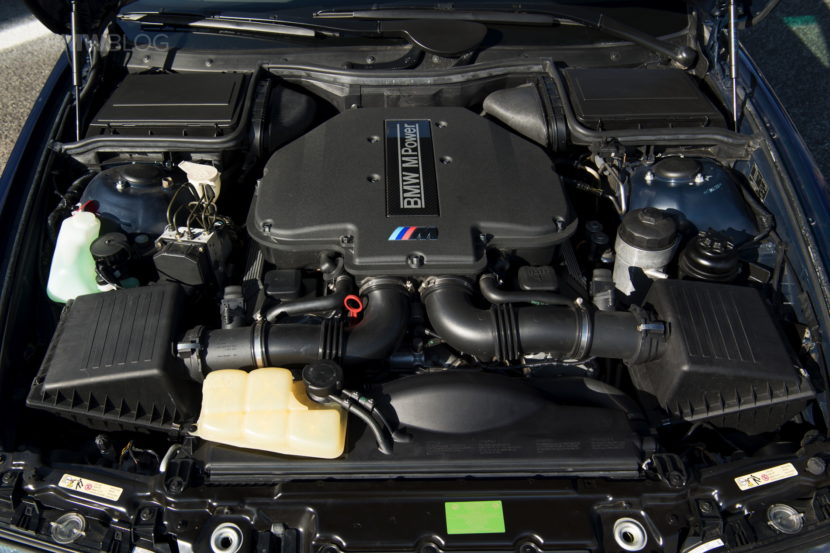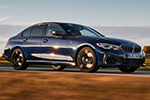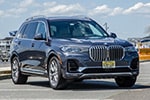2004-onwards BMW 6 Series values have gradually deflated down to the bargain basement – useable ones are just four grand. Should you buy one though? If four thousand bucks is all you have, then absolutely not, because nothing is more expensive than a cheap BMW. You’ll easily put $1,000 into one every year on consumables, but what a car! Lambasted when new – mainly by devotees of the prehistoric original E24 BMW 6 Series – the ‘Bangle butt’ moaning has receded somewhat now they are the price of some cloth-trimmed BMW 320d.
The History of the BMW 6 Series
Following the 2001 E65 7 Series and 2003 E60 5 Series (and E85 Z4 in 2003), the 2004 BMW 645Ci sold quite well even if the Adrian Van Hooydonk styling took a bit of getting used to. Coded E63 as a Coupe and E64 as a Convertible, the V8-powered 645Ci was the only model available at launch and was based on the E60 545i floorpan and running gear with the 333 bhp N62 V8 with all-alloy construction, double Vanos and Valvetronic, and variable length intake runners. This sat in front of either a six-speed manual gearbox or, far more commonly, the 6-speed ZF Steptronic auto. A rare option (thankfully) was the six-speed SMG with paddle shifts, interesting but a bit pointless when the auto was so good.
Suspension was all-alloy including the subframes, and with Servotronic speed-related power steering, plastic front fenders, and alloy panels, the fully equipped 645Ci was certainly a big leap forward over the last big BMW Coupe, the E31 840Ci. Standard spec included iDrive with central control, 18-inch wheels, multifunction steering wheel, DSC – dynamic stability control with ABS, Park Distance Control, rain-sensing wipers, tire pressure monitoring, and Xenon headlamps with washers. Options included dechroming, 19-inch alloys, satnav, active cruise control, adaptive Xenons, Dynamic Drive (self-adjusting anti-roll bars), climate sun protection glass, electric glass panoramic roof on Coupes, dark or light wood trim, sports seats and seat heating, plus a choice of upgraded Nav systems, radios, and speakers.
Weighing in at 1,695 kilos, the E63 645Ci Coupe wasn’t massively heavy either, although the Convertible added a good 150 kilos to that. Performance was excellent, limited to 155 mph all out and capable of hitting 60 mph in 5.4 seconds.
Early 2006 saw the 645Ci replaced by the 650i. Much the same as the 645Ci, the revised car used a 4.8-liter N62 V8 with 367 bhp. For the 2008 model year, the Six was revised once more – a centrally ridged hood, 3rd generation CIC iDrive, a new auto shifter and flappy paddles on the steering wheel, plus restyled wheels, lights, bumpers, and trim with the third brake light relocated into the trunk lid.
Nearly 117,000 Coupes and over 54,000 Convertibles were built in six years – compare that with 86,000 of the original E24 6 Series or the miserable 31,000 of the 8 Series – both with much longer production runs, and the car was judged a success.
An Affordable Car Today
The E63 BMW 6 Series is now a cheap car to buy by most standards, but these are complex and expensive cars to maintain, plus parts are expensive and they are not easy to work on. Many have been neglected, and because they don’t rust like the original 6 Series, a bad lot can still seem okay. They are not desirable on the used market and, as ever, clean cars with respectable owners, stamped service books, two keys, and a stack of history are the order of the day.
The Engine

The N62 V8 in both 4.4 liter and 4.8 forms is a superb engine when on top form, but it has its issues, and BMW techs absolutely hate them with a passion. They leak and sweat oil. The hard fixes are the rocker cover gaskets, and the real issue is the generator bracket. BMW sandwiched the generator alloy bracket between the crankcase and the two oil cooler pipes. The rubber seal hardens with age, and you get a very impressive oil leak as well as a bill for around $750 or more.

When the valve stem seals are finished, the car will smoke like a chimney, and that’s an expensive job with special tools to avoid removing the cylinder heads. Then we have the coolant cross tube, an alloy front-to-back pipe with a rubber seal at each end that BMW designed to be impossible to replace until the engine is out and dismantled. A coolant drip from the water pump area is NOT the pump, it’s this pipe. Sensible fixes include an extending pipe that can be fitted once the inlet manifold is off, or a repair pipe that slides inside the original once the water pump has been removed.
Timing chains plus the Vanos and the Valvetronic system are reliable, and regular oil changes are the key.
The Transmission
The standard six-speed manual box is rare, but you might want to seek one out as they never seem to go wrong and the dual-mass flywheels are long-lived. The 6-speed automatics are also good boxes, sealed for life with the Mechatronics ECU inside the box itself and the filter integral with the finned plastic oil pan. Whilst it’s nice to see bills for maintenance – oil and pan/filter and the rubber seal between the valve block and the transmission casing – don’t fret if it’s original and still working. You can have the oil and filter changed if you like or take the view that a good used gearbox isn’t very expensive. Check the box for oil leaks and correct them but there’s no point in going mad.
The SMG box is worth avoiding. It’s not a bad unit, but any repairs will be expensive and used parts almost non-existent. A conversion to manual is possible but again, pricey. Driveshafts and differentials are strong, and most of the driveline is shared with the E60 5 Series.
Suspension, Brakes and Steering
The 6 Series, like it did with the E24, is based on a contemporary 5 Series platform with 5 Series suspension, steering, and brakes. Unlike equivalent Mercedes with steel subframes, the 6 Series uses alloy, and the only problems are going to be bushes and ball joints. Use a good aftermarket supplier of suspension parts, and parts are quite cheap. Bilstein shock absorbers are about £150 a corner, so there is nothing particularly expensive to replace.
The same with brakes. The ABS control unit is reliable enough and cheap secondhand if you need one, calipers are expensive new, but rotors are around $200 a pair.
The 6 Series uses a hydraulic steering rack, and the standard servotronic version is shared with some E60 models – reckon on about £100 for a good used one, cheap as they rarely fail. The active steering version, however, is worth steering clear of if you’ll pardon the pun. A used rack is almost impossible to find and a new one about $3,000. A secondhand actuator might fix a faulty rack, but both this and the active anti-roll bars with their hydraulic motors are an indescribable price new and rare secondhand.
The wheels are an assortment of 18 or 19-inch alloys that can all be refurbished for around $100 a wheel for a simple blasting and powder coating job. Obviously, be wary of cheap tires or tire lotto where all four wheels have a different brand of tire.
Body, Electrics and Interior
The 6 Series shell is made from zinc-coated steel with alloy doors and bonnet plus reinforced plastic front fenders, bumpers, and trunk lid. It’s very well made so rust isn’t a problem, but you can find alloy corrosion by the top alloy door trim strip. The convertible roof is reliable enough, but the plastic gears in the rear roof latches can strip – you can buy replacement brass gears for £20 though. E64 Convertibles that sit outside all year round can be prone to water ingress leading to wet soundproofing and destroyed electrical modules under the carpets – if the car is condensating inside (wet windows), be very wary. On all cars, check the carpets in the rear and if wet, the front screen drains under the pollen filters will be blocked as well as the rear ones on the convertible.
Until September 2005 build date, the BMW 6 Series used a conventional key, replacing it with the later fob remote that slots into a revolving socket on the steering column. This later system had a module and a counter, and at some point, this will need clearing and resetting to zero.
As for electrical problems, the battery is critical on these – any bits not working, and you’re well advised to do a complete load test that can take 15 to 45 minutes just so you know what the battery has for CCA (cold cranking amps). A lot of ‘good’ batteries fail this test, and the 6 Series must have the correct-sized battery, fighting fit, and correctly coded to the car if required. A new battery has to be registered via OBD; otherwise, the IBS (Intelligent Battery Sensor) will think it is charging an old battery.
If it is an AGM battery (later BMWs with auto stop-start), you need a VARTA H15 105ah (or 95ah depends on what’s coded in the car). If it is a normal battery, you need a VARTA I1 110ah. If you don’t use the car much, invest in a good battery maintenance charger. A bad generator voltage regulator can cause problems, and what an absolute joy they are to replace on the V8.
As for the interior trim, it’s all good solid stuff, and the leather is proper as well. Make sure the iDrive works as it should, but you may find that the TV function and sat nav are a bit rubbish by modern standards. The TV may well be useless, but the nav should still work with a decent disc fitted.











































































